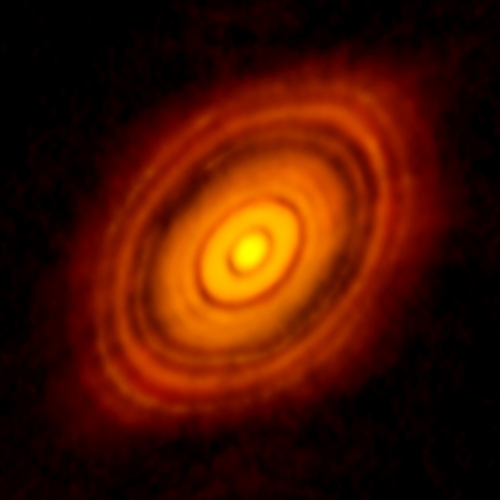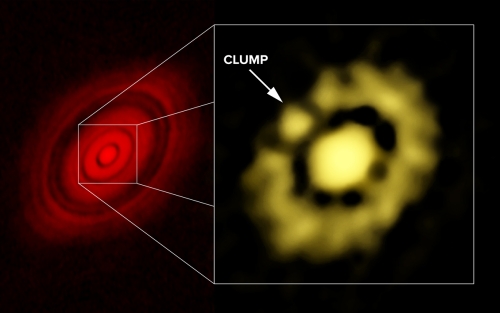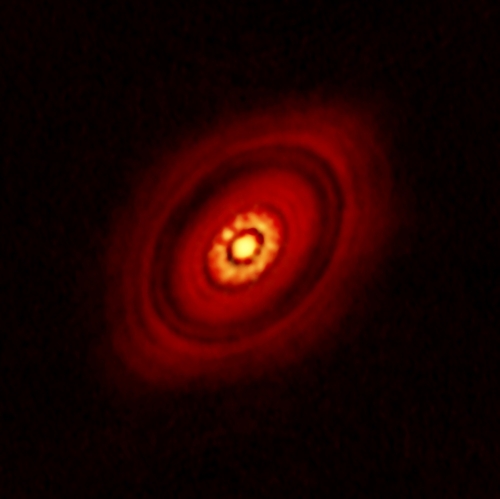Back in 2014, astronomers used the Atacama Large Millimeter/submillimeter Array (ALMA) to produce high-resolution images of the planet-forming disk around the Sun-like star HL Tau, about 450 light years away in the constellation Taurus. The images were striking, showing bright and dark rings with gaps, suggesting a protoplanetary disk. Scientists believed the gaps in the disk were caused by planets sweeping out their orbits.
All this was apparent confirmation of planet formation theories, but also a bit of a surprise given the age of the star, a scant million years, making this a young system indeed. Here is the ALMA image, along with the caption that ran with the original release of the story from NRAO.

Image: The young star HL Tau and its protoplanetary disk. This image of planet formation reveals multiple rings and gaps that herald the presence of emerging planets as they sweep their orbits clear of dust and gas. Credit: ALMA (NRAO/ESO/NAOJ); C. Brogan, B. Saxton (NRAO/AUI/NSF).
Now we have further work on HL Tau, this time based on data from the Very Large Array (VLA). As opposed to the ALMA work, which showed details in the outer portions of the disk only, the VLA findings, working at longer wavelengths, get us into the inner portions of the disk. At these wavelengths (7.0 mm), the dust emission from the inner disk can be penetrated.
What we see is what this NRAO news release calls ‘a distinct clump of dust’ in the inner disk region, one that contains from 3 to 8 times the mass of the Earth. The researchers believe they are looking at the earliest stage in the formation of protoplanets, seen in the image below for the first time. Not a ‘planet,’ mind you, but a ‘clump of dust.’

Image: ALMA image of HL Tau at left; VLA image, showing clump of dust, at right.
Credit: Carrasco-Gonzalez, et al.; Bill Saxton, NRAO/AUI/NSF.
“This is an important discovery, because we have not yet been able to observe most stages in the process of planet formation,” said Carlos Carrasco-Gonzalez from the Institute of Radio Astronomy and Astrophysics (IRyA) of the National Autonomous University of Mexico (UNAM). “This is quite different from the case of star formation, where, in different objects, we have seen stars in different stages of their life cycle. With planets, we haven’t been so fortunate, so getting a look at this very early stage in planet formation is extremely valuable,” he added.
The inner region of the disk, thought to contain grains as large as one centimeter in diameter, is where Earth-like planets would be likely to form as aggregations of dust accumulate and draw in material, eventually gathering the mass to form the planetesimals that become planets. The paper on the VLA work argues that we are looking not at planets that have already formed in gaps in the dusty disk, but at the very earliest stages of future planet formation:
We propose a scenario in which the HL Tau disk may have not formed planets yet, but rather is in an initial stage of planet formation. Instead of being caused by (proto)planets, the dense rings could have been formed by an alternative mechanism. Our 7.0 mm data suggest that the inner rings are very dense and massive, and then, they can be gravitationally unstable and fragment. It is then possible that the formation of these rings result in the formation of dense clumps within them like the one possibly detected in our 7.0 mm image. These clumps are very likely to grow in mass by accreting from their surroundings, and then they possibly represent the earliest stages of protoplanets. In this scenario, the concentric holes observed by ALMA and VLA would not be interpreted as a consequence of the presence of massive (proto)planets. Instead, planets may be just starting to form in the bright dense rings of the HL Tau disk.
The following image pulls the ALMA and VLA work together.

Image: Combined ALMA/VLA image of HL Tau. Credit: Carrasco-Gonzalez, et al.; Bill Saxton, NRAO/AUI/NSF.
The paper is Gonzalez et al., “The VLA view of the HL Tau Disk – Disk Mass, Grain Evolution, and Early Planet Formation,” accepted by Astrophysical Journal Letters (preprint).



Great work. We know what ALMA can do for planetary formation already as underlined here. Fabulous tool all round. It’s difficult to imagine what the Square Kilometre array, SKA, will add next decade given the results from the VLA. If they create “OLBA”, Overwhelmingly Large Baseline Array, as I’m sure will occur eventually by combining SKA with the VLBA, all the other VLAs and orbital radio telescopes as well, the resolution will be truly awesome.
What we need now is the equivalent for shorter wavelengths . Interferometry is the future for visual high resuloltion too given the physical and cost limitations on large telescopes even as technology improves . I’m certain with the heterodyne design a big breakthrough that the process of storing and combining observations at this wavelength is getting nearer and nearer to that of longer wavelengths with added help from increasing processing power.
Spektr-R, the 10 meter (four times Hubble) Russian space radio telescope, is used in the Very Long Baseline Interferometer, at up to a Lunar distance. It’s been up during 5 years now, but little seems to come out of it. The Chinese 500 meter radio telescope FAST should get its first light this year. With ALMA and SKA and more going on, things are looking good for radio astronomy. More large space radio telescopes could provide terrific resolution, even if Spektr-R hasn’t been a sensation yet
If their suggested model is correct, wouldn’t that imply that several planets could form in the same orbit from different clumps? (Doesn’t the gap around the clump imply that there are other aggregating clumps nearby?)
Another possibility is that a number of proto planets in very similar orbits interact, resulting in very different orbits for each.
There are computer simulations of planetary formation. Shouldn’t they have found such patterns, or can they be made to do so with minor parameter tweaks?
Interesting, conclusion about what the gaps and bright rings mean.
As I recall the mantra has been that the gaps are were planitesimals
were forming. This new analysis seems to conclude that if we take a step
or two back, we find an inverse relationship between gaps and bright rings.
For stars of this type and age.
The Gaps are less dense areas, rather than the signature of some solid body.
And the Bright areas a coalescing and densification of future material to
form planitesimals.
Fast forward 10 million years, and for the same system we will have
negative image effect, the only remaining signs of the initial solar nebula
are the remaining dust/gas where gravity tugs from planitesimals conspire to work against clumping and the creation of large bodies there.
These images make me think of the supernova SN1987A .You can see a picture here :
http://www.jmmasuy.net/mort_etoiles/mort_etoiles_4_exemples_supernovae.html
This ring of pearls looks like those clumps or planets in the making.
And so maybe gravity is not the main culprit but electromagnetic forces.
Could these clumps be the product of electrostatic precipitation and /or magnetic forces ?